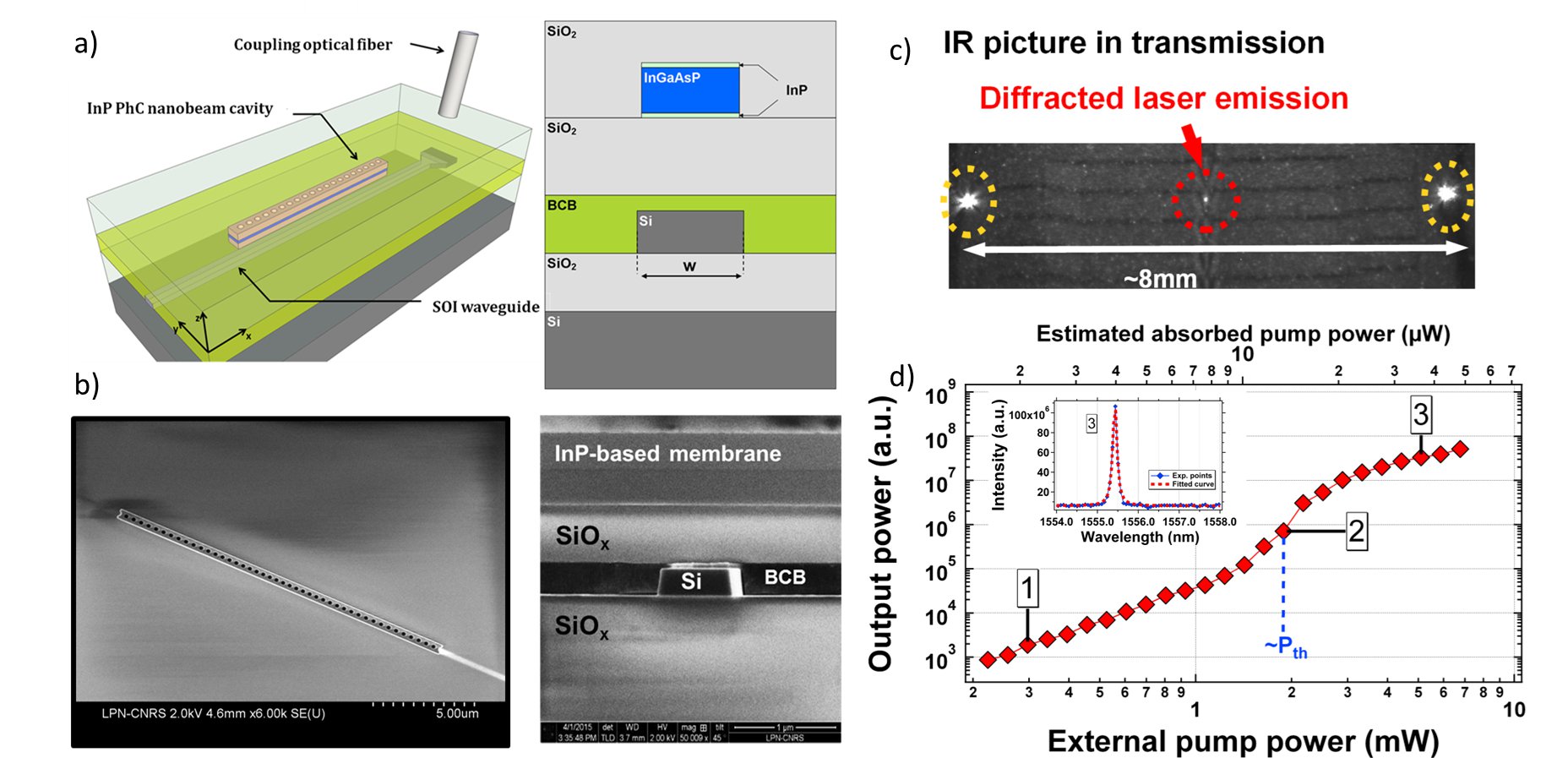Electrically powered hybrid InP-on-SOI nanolaser diodes (Nature Photonics)

Involved People: Francesco MANEGATTI (PhD), Dimitris FITSIOS (Postdoc), Fabrice RAINERI (PI)
The most-awaited convergence of microelectronics and photonics promises to bring about a revolution for on-chip data communications and processing. Among all the optoelectronic devices to be developed, power-efficient nanolaser diodes able to be integrated densely with silicon photonics and electronics are essential to convert electrical data into the optical domain.
In our team, we have identified photonic crystals nanocavities to be the best suited candidates for low thresholds or even thresholdless laser operation with ultrafast dynamics. Indeed, these structures provide tight localization of the electromagnetic field enabling enhanced light–matter interaction and the control of spontaneous emission. More precisely, we have been working on hybrid structures comprising an InP-based photonic crystal nanocavity positioned on top of a silicon on insulator waveguide (see Figure below a) and b)) to allow evanescent wave coupling.

a) 3D schematical view and crossection of our optically pumped hybrid InP-on-SOI nanolasers. b) Scaning electron microscope top view and crossection our nanolasers. c) IR optical image of the light emitted by the hybrid nanolaser: the red circle denotes the light vertically emitted by the nanolaser whereas the yellow circles indicate the emitted ligtht diffracted by the grating couplers etched at the extremities of the SOI waveguide. d) Characteristic light-light curve of an hybrid nanolaser emitting at 1.55µm.
However, electrically driven stable room temperature CW lasing with output powers beyond a few microwatts remains a challenge, as several hurdles have to be overcome simultaneously: nanometre-precise material processing, poor heat sinking, large non-radiative surface recombination of carriers, complex optical interfacing and electrical injection.
Our goal is to propose innovative approaches to solve each and everyone of these issues and to explore novel concept of nanolasers taking advantage of the versatility of the hybrid configuration.
Methods
Our team follows a methodological approach based on the tackling of the challenges to be taken up in the 3 fronts which are the design and modelling", the material growth and nanoprocessing, and the experimental assesments. To know more, click on the images.
Highlights:
Publications:
Hybrid indium phosphide-on-silicon nanolaser diode
G. Crosnier, R. D. Sanchez, S. Bouchoule, P. Monnier, G. Beaudoin, I. Sagnes, R. Raj, F. Raineri, Nature Phot. 11, 297 (2017)
High Q-factor InP Photonic Crystal Nanobeam cavities on Silicon wire waveguides
G. Crosnier, D. Sanchez, A. Bazin, P. Monnier, S. Bouchoule, R. Braive, G. Beaudoin, I. Sagnes, R. Raj, F. Raineri, Opt. Lett. 41, 579 (2016)
Subduing surface recombination for continuous-wave operation of photonic crystal nanolasers integrated on Silicon waveguides
G. Crosnier, A. Bazin, V. Ardizzone, P. Monnier, R. Raj, F. Raineri, Opt. Express 23, 27953 (2015)
Thermal management in hybrid InP/silicon photonic crystal nanobeam laser
A. Bazin, P. Monnier, X. Lafosse, G. Beaudoin, R. Braive, I. Sagnes, R. Raj, F. Raineri, Opt. Express 22, 10570 (2014)
Design of Silica Encapsulated High-Q Photonic Crystal Nanobeam Cavity
A. Bazin, R. Raj, F. Raineri, J. Lightwave Technol. 32, 952 (2014)
Towards a monolithically integrated III–V laser on silicon: optimization of multi-quantum well growth on InP on Si
H. Kataria, C. Junesand, Z. Wang, W. Metaferia, Y. T. Sun, S. Lourdudoss, G. Patriarche, A. Bazin, F. Raineri, P. Mages, N. Julian, J. E. Bowers, Semicond. Sci. Technol. 28, 094008 (2013)
Experimental demonstration of a hybrid III–V-on-silicon microlaser based on resonant grating cavity mirrors
Y. de Koninck, F. Raineri, A. Bazin, R. Raj, G. Roelkens, R. Baets, Opt. Lett. 38, 2493 (2013)
Uniformity of the lasing wavelength of heterogeneously integrated InP microdisk lasers on SOI
P. Mechet, F. Raineri, A. Bazin, Y. Halioua, T. Spuesens, T. J. Karle, P. Regreny, P. Monnier, D. Van Thourhout, I. Sagnes, R. Raj, G. Roelkens, G. Morthier, Opt. Express 21, 10622 (2013)
Hybrid III-V semiconductor/silicon nanolaser
Y. Halioua, A. Bazin, P. Monnier, T. J. Karle, G. Roelkens, I. Sagnes, R. Raj, F. Raineri, Opt. Express 19, 9221 (2011)
III-V photonic crystal wire cavity laser on silicon wafer
Y. Halioua, A. Bazin, P. Monnier, T. J. Karle, I. Sagnes, G. Roelkens, D. Van Thourhout, F. Raineri, R. Raj, J. Opt. Soc. Am. B-Opt. Phys. 27, 2146 (2010)
Heterogeneous integration and precise alignment of InP-based photonic crystal lasers to complementary metal-oxide semiconductor fabricated silicon-on-insulator wire waveguides
T. J. Karle, Y. Halioua, F. Raineri, P. Monnier, R. Braive, L. Le Gratiet, G. Beaudoin, I. Sagnes, G. Roelkens, F. Van Laere, D. Van Thourhout, R. Raj, J. Appl. Phys. 107, 63103 (2010)
Hybrid InP-based photonic crystal lasers on silicon on insulator wires
Y. Halioua, T. J. Karle, F. Raineri, P. Monnier, I. Sagnes, G. Roelkens, D. Van Thourhout, R. Raj, Appl. Phys. Lett. 95, 201119 (2009)
Dynamics of band-edge photonic crystal lasers
F. Raineri, A. Giacomotti, T. J. Karle, R. Hostein, R. Braive, A. Beveratos, I. Sagnes, R. Raj, Optics Express 17, 3165 (2009)
Light emission and enhanced nonlinearity in nanophotonic waveguide circuits by III-V/silicon-on-insulator heterogeneous integration
R. Notzel, G. Roelkens, L. Liu, D. Van Thourhout, R. Baets, R. Notzel, F. Raineri, I. Sagnes, G. Beaudoin, R. Raj, J. Appl. Phys. 104, 33117 (2008)
Continuous-wave operation of photonic band-edge laser near 1.55 µm on silicon wafer
G. Vecchi, F. Raineri, I. Sagnes, A. Giacomotti, P. Monnier, T. J. Karle, K.-H. Lee, R. Braive, L. Le Gratiet, S. Guilet, G. Beaudoin, A. Talneau, S. Bouchoule, JA. Levenson, R. Raj, Optics Express 15, 7551 (2007)
Photonic-crystal surface-emitting laser near 1.55 micron on gold-coated silicon wafer
G. Vecchi, F. Raineri, I. Sagnes, K.-H. Lee, S. Guilet, L. Le Gratiet, F. Van Laere, G. Roelkens, D. Van Thourhout, R. Bats, JA. Levenson, R. Raj, Electron. Lett. 43, 343 (2007)